|
|
#1 |
|
Digital Dancing!
Join Date: Feb 2006
Location: 80 billion club, NE
Age: 31
Posts: 12,982
|
This is an original work that I am using for CIST 1300 at the University of Nebraska at Omaha during the fall 2012 semester.
Welcome to my 4x4 Rubik's Cube tutorial thread. WARNING: this is not a thread for beginning cubers, if you can't solve the 3x3 cube, you won't stand a chance with the 4x4. You can find my 3x3 tutorial here. This tutorial was designed to not function unless you have either read my 3x3 tutorial or already know how to solve the cube. If you haven't mastered the 3x3 (able to solve in <2:30), you're in the wrong thread. Disclaimers/warnings aside, let's get this thing rollin' shall we?? Table of Contents I. .....Some new notation II. ....Creating the centers III. ...Making the dedges IV. ...Solving the first two layers V. ....Top cross parity VI. ...Basic Method permutation parity VII. ..2-look OLL/PLL permutation parity ----------------------------------------------------- I. Some new notation The basic notation on the cube is pretty much the same as the 3x3 with a few exceptions. The standard cube notation for Right, Up, Down, Left, Front, (and rarely) Back will remain the same (R, U, D, L, F, B), but additionally, on the 4x4 cube, you will notice that there are more than just 3 layers to be dealt with. With one more layer comes one more form of possible movement. The notation used to denote turning two of the layers at the same time (half the cube) is expressed in the form "Aa, of course A isn't a legitimate layer on the cube, but I just used it for an example. One algorithm you will be using later for a special parity case is this: Rr2 B2 U2 Ll U2 Rr' U2 Rr U2 F2 Rr F2 Ll' B2 Rr2. Notice that this algorithm contains several instances of the new notation. Another new type of notation is just the single lowercase letter a. This is used to represent a turn of the inside layer on a given face. To put it simply, it's turning both the outside layers, except for the outermost. (see picture below). It's not a hard to grasp, but it's crucial that you understand the difference between A, a, and Aa. Rr: 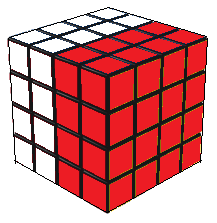 r:  Finally, you might have noticed already that there are no centers on this cube, but when you think about the definition of a center piece, it's just a cubelet with only 1 sticker on it. There are center pieces on this cube, there are just 4 for each color! This will be explained in greater detail in the next section. In addition to the surplus of center pieces, there are also double the edge pieces. For each edge piece of any given 2 colors, there is a twin with the exact same 2 colors on it. When these two 'twins' have been matched up, they are called a dedge (double edge). These dedges will be explained in greater detail in section III. Now that notation is out of the way, it's time to move on to the next step! II. Creating the centers Remember how I said there were 4 cubelets for each color? Well, the first step in solving the 4x4 is to pair these up on all sides. At first, I suggest you try messing around with the cube first and try to do this step on your own, for it is fairly intuitive. I'm not going to leave you all alone though, here are some tips to help you out: 1. There is no fixed center piece on any of the sides, so you have to actually learn how the centers are supposed to be so you don't end up having an unsolvable cube. The way I ALWAYS start with the 4x4 is first solving the red center, then the white center to the left of the red center, and finally the blue center above the white/red corner: example: 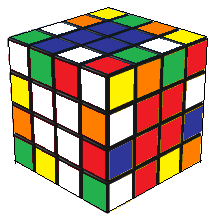 Once these centers are done, you can use the opposites of these colors to solve the remaining centers (opposites are blue/green, white/yellow, red/orange [if you didn't know this already, solve the 3x3 some more]) 2. Here is the method used to match up 2 pairs of center pieces without disturbing the rest of the centers: Put what you're aligning in the same column as what you're putting it with and do the algorithm: Rr U2 Rr'. This is an intuitive algorithm and can also be used on the left side, experimentation works best. image form: 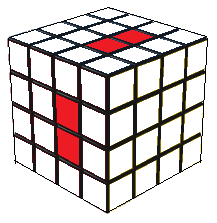 Orient your cube like this (bottom set of vertical reds to the front) and do the algorithm above. 3. This is a variation on the above case where you have an L-like shape on the top face and a single dot on the front face. Arrange it so that the dot, when flipped up to the top layer will be in the same position as the corner of the L (this can be achieved by rotating the front face). When it's properly oriented, there isn't really a specific algorithm that goes with this, but with the instance in the image below, it's Rr U Rr'. Basically what you're doing is flipping the single center up, pairing it with one from the L, turning the top face to get what you just solved out of the way of the Rr' which will undo the Rr from the beginning of the algorithm. At the same time, it puts the center pair that you just moved back in place and completed the center. image: 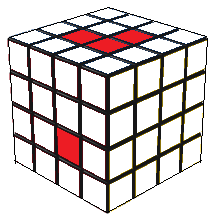 Like I said, there isn't really an algorithm that goes with this, but you should be able to figure it out with intuition. Now that the centers are solved (and in the CORRECT position) lets move on to the scavenger hunt: III. Making the dedges Note: All the normal faces (U,D,R,L,F,B) can be turned freely during this stage without risk of messing up previous progress. The purpose of this step is to pair edge pieces with their twins to create "dedges". The first step in doing so is to find these edge pairs. Once you find 2 that are alike, twist the normal faces any way you choose to get them both on the same face and make that face the front. Here is where you can get one of two cases: First: 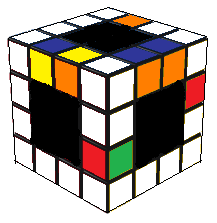 (assume the other red edge is a red/green edge as well.) (assume the other red edge is a red/green edge as well.)Second: 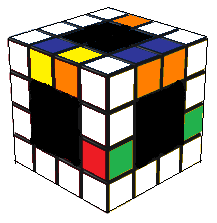 (assume the other green edge is a green/red edge as well.) (assume the other green edge is a green/red edge as well.)The first case is correct and what you want to proceed. If you run into the second case, do the algorithm R' D' L F' L' and you should get the first case. Note: It won't always look exactly like the image, but the concept is to have the two edges on the same face, but with different colors facing you (like in first image). This next step involves an intuitive algorithm. I'll just use one specific case and leave you to figure out the other permutations of the same algorithm on your own. Once you get the first case, turn the top layer until an unmatched pair is on the left side (in this case [yes this is important]). Do the algorithm: Uu L' U' L Uu'. Basically what this is doing is: 1. pairing up your dedge (Uu) 2. putting it in the top layer (L') 3. moving it out of the way (U') 4. replacing it with an unpaired dedge (L) [this is why the unmatched pair is important] 5. Fixing your centers (Uu') Instead of memorizing that algorithm, think of it as those 5 steps. Always put the unmatched pair to the right if you're going to be turning the Uu layers to the right (Uu') and put the unmatched pair to the left if you're going to be turning the Uu layers to the left (Uu). The rest should follow the pattern. example image: 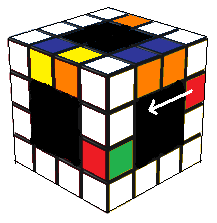 -The unmatched pair is on the left since the edge being paired needs to be rotated left -The newly formed dedge will be moved up to the top and moved out of the way to be replaced by the unmatched dedge. -Fix the centers with Uu' Once you do this a few times you might possibly run into your first parity case. This one isn't too bad, but it occurs when you're down to your final 2 unsolved dedges. Thankfully, there is a fixed algorithm for this case, but first you need to arrange the front face so it looks like the image below using the (R' D' L F' L') algorithm from before if necessary: example image: 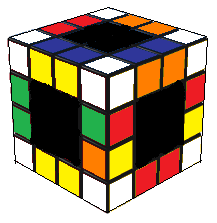 (assuming the edges you can't fully see are red/green and yellow/orange) (assuming the edges you can't fully see are red/green and yellow/orange)Once you get to this stage, do the algorithm Dd R F' U R' F Dd'. The edges should now be fixed. Look familiar? The end is near.  IV. Solving the first two layers Your cube is now a 3x3. Solve the first two layers accordingly. 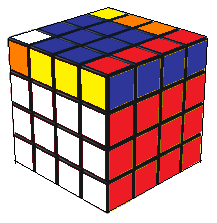 That was easy  V. Top cross parity That last step was easy, this one won't be. If you have a dot, L, line, or cross already, congratulations, you just skipped an extremely annoying step. If you have 3/4 of a line or 3/4 of a cross, uncongratulations, here we go.. This, my friends, is your first true encounter of parity at its finest. If you have 3/4 of a line, pretend it's an L and try to solve for the cross and you should get something similar to this: 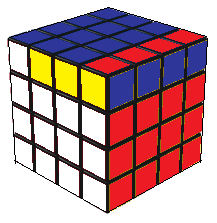 It's almost a cross on top, but you're last dedge is flipped upside down. How do we fix it? With none other than a 25 move algorithm!!! WOOOOOOOOT.. no? Well, just face the cube so the screwed up dedge is facing you and do (takes a deep breath): Rr2 B2 U2 Ll U2 Rr' U2 Rr U2 F2 Rr F2 Ll' B2 Rr2 This is a bad one to screw up, so don't. Your top cross should now be fixed. Continue solving the cube to completion. Don't worry if you encounter another parity case in the end. This will happen when you're putting the corners in the right spots. If they won't all match up no matter how many (U' L' U R U' L U R')s you do, just do the final (R' D' R D)s and get the correct color to the top and continue and finish solving. I will cover the parity cases in the next section. VI. Basic Method permutation parity -Thanks to cry4eternity to helping me out with this section. It's greatly appreciated.- Ready for some more 25+ move algorithms? Good, because there's 2 special parity cases in the basic method. One: 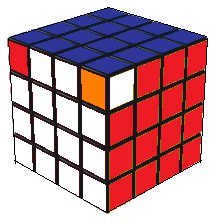 Two: 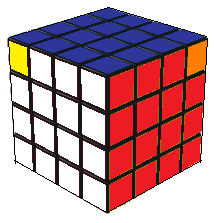 If you get case one, do the algorithm: 2Uu 2Ll 2U 2l 2U 2Ll 2Uu F' U' F U F R' 2F U F U F' U' F R With the two unsolved corners on the top face, facing the front. If you get case two, do the algorithm: 2Uu 2Ll 2U 2l 2U 2Ll 2Uu R U' L 2U R' U R L' U' L 2U R' U L' U With one of the corners on the top face on the bottom right, the other on the top face on the upper left. Alternatively, you can do U R U' L' U R' U' L to turn it into the adjacent case, so you only have to memorize one insanely long algorithm. Your cube should be solved. Alternate method: (pending 2-look OLL/PLL tutorial next week) VII. 2-look OLL/PLL permutation parity The one and only permutation case for this method is short and sweet: 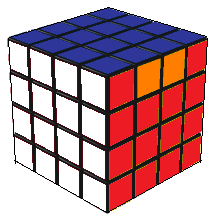 2 edges are swapped, the other 2 are solved. If the two edges are opposite, make sure one of them is facing you, if they are adjacent, do this from any side (as long as the top is still the same) Algorithm: Uu2 Rr2 U2 r2 U2 Rr2 Uu2 If you had the adjacent case, you will need to do an edge rotation algorithm, then.. Your cube should be solved. Congratulations! You have just solved the 4x4 cube! Have a brownie.  Algorithm quick reference: Align middle without screwing up the rest: put what you're aligning in the same column as what you're putting it with and do: Rr U2 Rr' Edge pairing: Uu L' U' L Uu' Edge in the wrong position: R' D' L F' L' Last 2 edges: Line up so the pairs are in the same row and: Dd R F' U R' F Dd' Top Cross parity: Rr2 B2 U2 Ll U2 Rr' U2 Rr U2 F2 Rr F2 Ll' B2 Rr2 2-look OLL/PLL parity: Uu2 Rr2 U2 r2 U2 Rr2 Uu2 Basic parity (diag): U R U' L' U R' U' L Basic parity (solve from diag): 2Uu 2Ll 2U 2l 2U 2Ll 2Uu R U' L 2U R' U R L' U' L 2U R' U L' U Basic Parity (adj): 2Uu 2Ll 2U 2l 2U 2Ll 2Uu F' U' F U F R' 2F U F U F' U' F R
__________________
      
Last edited by rushyrulz; 12-3-2012 at 04:43 PM.. |
|
|

|
| Currently Active Users Viewing This Thread: 1 (0 members and 1 guests) | |
|
|